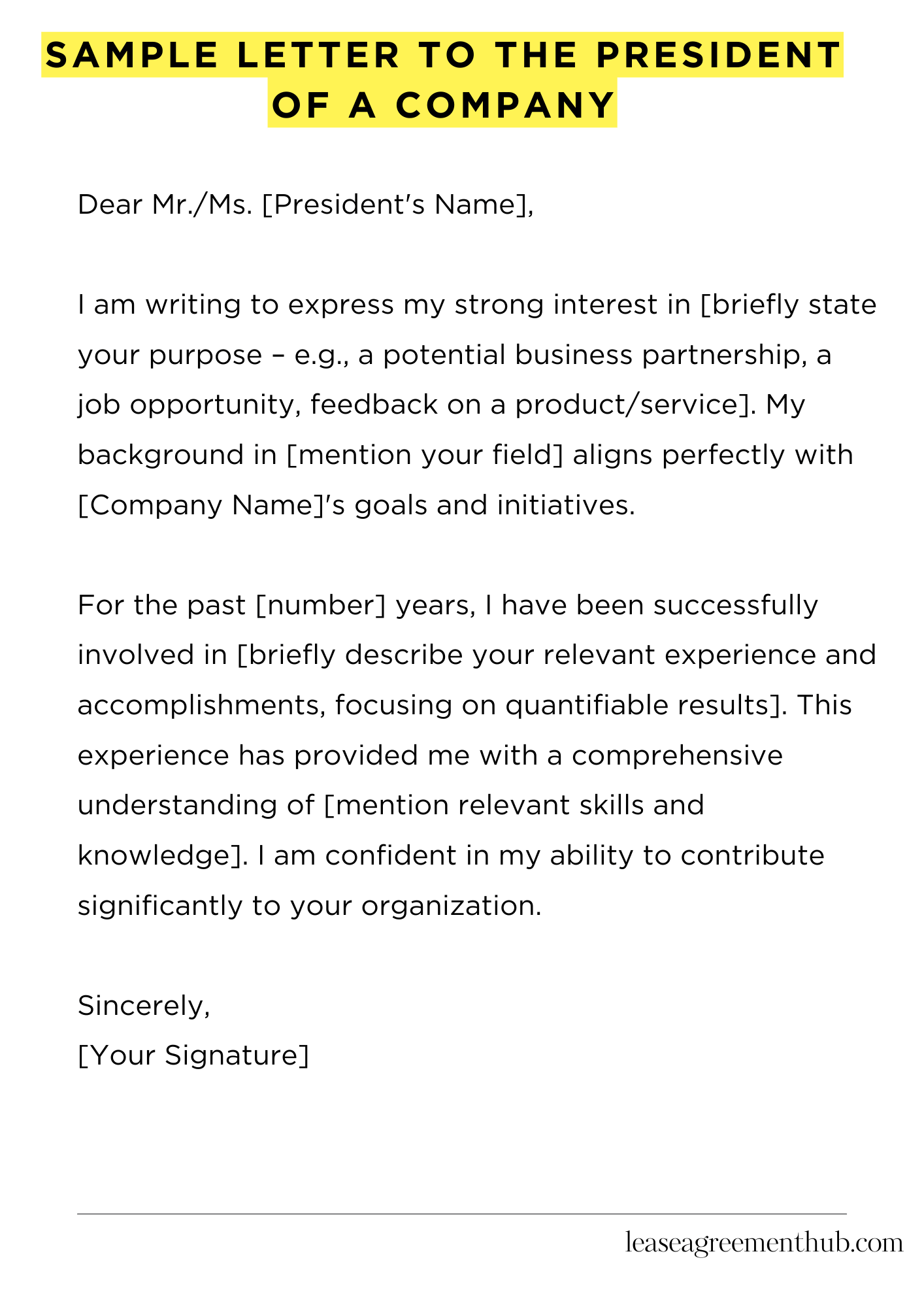Need to contact a company president? A sample letter provides a helpful template. It shows you how to write a professional and effective letter.
This article gives you several examples. These samples cover different situations. They’ll help you craft your own perfect letter.
Use these templates as a starting point. Adapt them to your specific needs. Writing a great letter is easier than you think.
Sample Letter to the President of a Company
[Your Name]
[Your Address]
[Your Phone Number]
[Your Email Address]
[Date]
Mr./Ms. [President’s Name]
President, [Company Name]
[Company Address]
Dear Mr./Ms. [President’s Name],
I am writing to express my strong interest in [briefly state your purpose – e.g., a potential business partnership, a job opportunity, feedback on a product/service]. My background in [mention your field] aligns perfectly with [Company Name]’s goals and initiatives.
For the past [number] years, I have been successfully involved in [briefly describe your relevant experience and accomplishments, focusing on quantifiable results]. This experience has provided me with a comprehensive understanding of [mention relevant skills and knowledge]. I am confident in my ability to contribute significantly to your organization.
I have been consistently impressed by [Company Name]’s commitment to [mention something specific you admire about the company – e.g., innovation, sustainability, customer service]. Your recent work on [mention a specific project or achievement] is particularly noteworthy. It demonstrates a forward-thinking approach that I greatly respect.
I have attached my resume for your review, which further details my qualifications and experience. I am available to discuss this matter further at your convenience. Thank you for your time and consideration. I look forward to hearing from you soon.
Sincerely,
[Your Signature]
How to Write a Sample Letter to the President of a Company
Understanding Your Objective: A Crucial First Step
Before even thinking about penning a single word, clarify your purpose. Are you seeking an investment? Reporting a significant issue? Soliciting advice? Defining your desideratum is paramount. A vague letter will likely languish unread. Knowing precisely what you want to achieve dictates the letter’s tone and structure. Precision is key.
Crafting a Compelling Salutation: More Than Just a Greeting
Avoid generic greetings. Research your recipient; using a formal title like “Mr. President” or “Madam President” is essential, unless you have established a prior, informal relationship. A personalized salutation demonstrates respect and attention to detail – qualities valued by busy executives. Impersonal openers are a disservice to your communication.
Structuring Your Argument: A Persuasive Narrative
Employ a clear, concise structure. Begin with a brief, compelling introduction outlining the core of your message. Subsequent paragraphs should elaborate on key points using evidentiary support where relevant. Using bullet points for key information can enhance readability. A strong conclusion reiterates your main point and suggests a desired outcome or next steps. Avoid obfuscation.
The Importance of Tone: Projecting Professionalism
Maintain a professional, respectful tone throughout. Avoid emotive language or hyperbole. Confidence is admirable, but arrogance is a deterrent. Your letter should project competence and gravitas. Consider the overall impression you wish to convey.
Mastering the Art of Conciseness: Brevity is the Soul of Wit
Executives are inundated with correspondence; brevity is paramount. Get to the point quickly and efficiently. Eliminate unnecessary words and phrases. A succinct, well-crafted letter is far more effective than a rambling, verbose one. Every word should serve a purpose.
Proofreading and Editing: A Final, Critical Step
Before sending, meticulously proofread your letter. Grammatical errors and typos undermine your credibility. Have a trusted colleague review it for clarity and tone. A pristine letter reflects professionalism and respect for the recipient’s time. Overlooking this step is an egregious error.
Preparing for the Follow-Up: Maintaining Momentum
Sending a letter is often just the first step. Consider outlining a follow-up strategy. A phone call a few days later can be invaluable in ensuring your letter is addressed. Persistence, while remaining respectful, is critical for achieving results. Don’t let your effort fizzle out.
FAQs about sample letter to the president of a company
Writing a letter to a company president requires careful consideration. This FAQ section addresses common concerns regarding the process and content.
What is the appropriate tone for a letter to a company president?
The appropriate tone is generally formal and respectful. Avoid slang, colloquialisms, and overly informal language. Maintain a professional demeanor throughout the letter, even if expressing criticism or concern. Clarity and conciseness are key.
What information should be included in the letter?
Your letter should clearly state your purpose, whether it’s to express appreciation, offer feedback, make a complaint, request information, or propose a collaboration. Include relevant background information and support your statements with facts and evidence. Be sure to provide your contact details.
How should I structure the letter?
A typical structure follows a standard business letter format: A formal salutation (e.g., “Dear Mr./Ms./Mx. [President’s Last Name]”), an introduction stating your purpose, a body presenting your main points and supporting evidence, a conclusion summarizing your request or position, and a formal closing (e.g., “Sincerely,” or “Respectfully,”).
What is the best way to address the president if their name is unknown?
If the president’s name is unknown, you can address the letter to “The President,” “The President and CEO,” or “To Whom It May Concern.” However, making an effort to find the president’s name is preferable, as it demonstrates initiative and professionalism. You might find this information on the company website.
How should I follow up after sending the letter?
Depending on the urgency and nature of your letter, a follow-up may be appropriate. A brief email or phone call a week or two after sending the letter is generally acceptable, inquiring whether the letter was received and if a response is expected. Be polite and respectful in your follow-up communication.
Related: